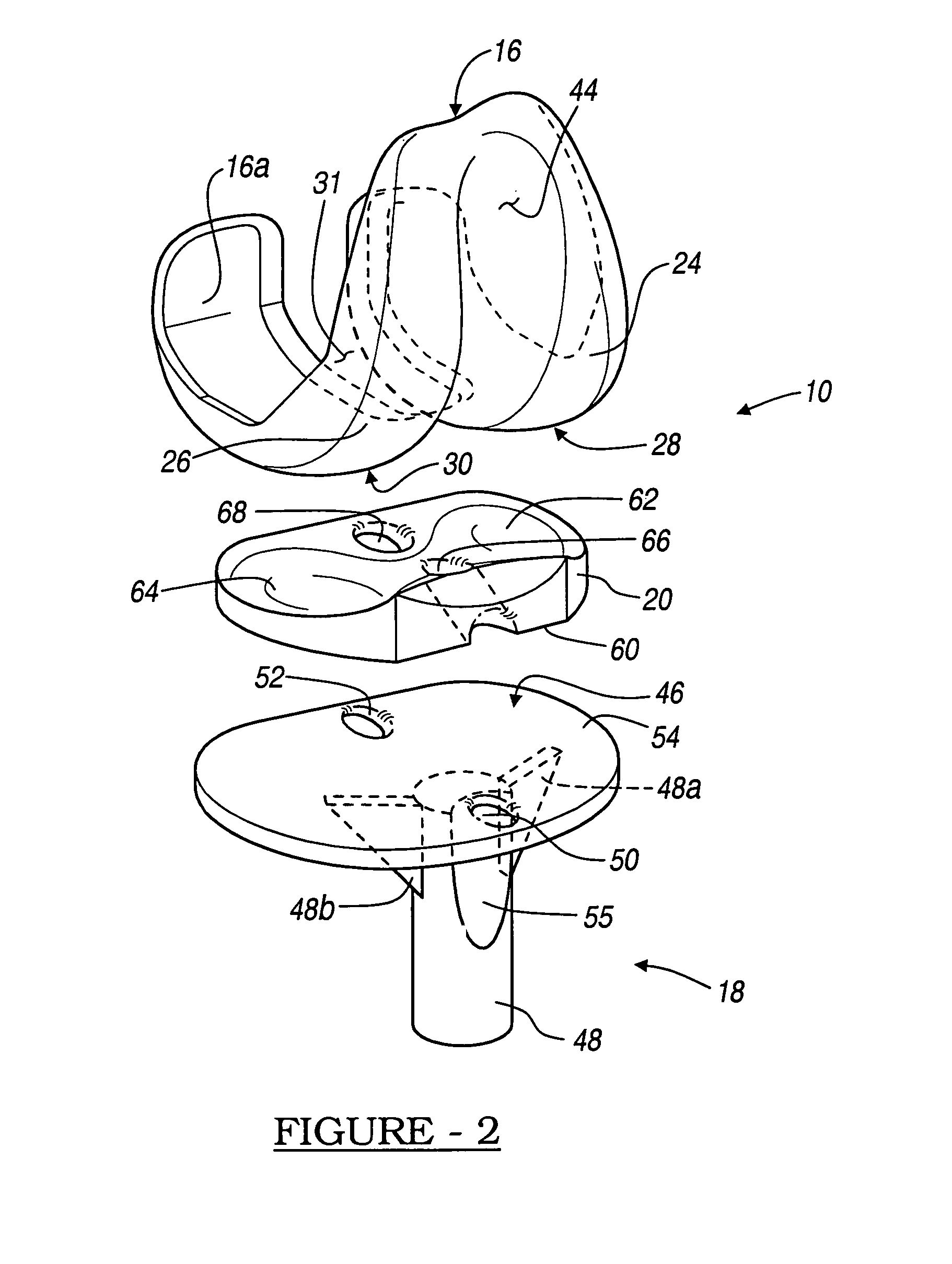Knee prosthesis with graft ligaments
a knee joint and prosthesis technology, applied in the field of knee joint prosthesis, can solve the problems of general difficulty and reduce the choice of surgeons
- Summary
- Abstract
- Description
- Claims
- Application Information
AI Technical Summary
Benefits of technology
Problems solved by technology
Method used
Image
Examples
first embodiment
[0040]In the first use of the first embodiment illustrated in FIGS. 1–5, the ACL graft 70 is configured to replicate the function of the biological ACL. In this configuration the ACL graft 70 is connected to the tibia 12 and the femur 14 in a configuration as shown in FIGS. 3–5 and described above. The ACL graft 70 helps prevent posterior subluxation of the femur 14. A second use includes a PCL graft 90 interconnecting the tibia 12 and the femur 14. As the knee joint is moved from extension to flexion, particularly shown in FIGS. 10a–10e, the PCL graft 90 restrains the posterior movement of the tibia 12 with respect to the femur 14 and causes rollback.
[0041]With references to FIG. 6, a third use of the first embodiment of the knee prosthetic 10 is illustrated. The knee prosthetic 10 illustrated in FIG. 6 is substantially identical to the knee prosthetic 10 as described in relation to FIGS. 1–5. Illustrated in FIG. 6, is the knee prosthetic 10 including both the implantation of the A...
second embodiment
[0062]With reference to FIGS. 8 and 9, a knee prosthetic 100 is illustrated where like numerals identify like portions noted above. The knee prosthetic 100 includes a femoral component 102, a bearing 104, and a tibial component 106. The femoral component 102 includes a first condyle 108 and a second condyle 110. The first condyle 108 defines a first femoral bearing surface 112 and the second condyle 110 defines a second femoral bearing surface 114. A femoral clearance 115 is defined between the first condyle 108 and the second condyle 110. A patellar groove 116 is defined between the first condyle 108 and the second condyle 110. The patellar groove 116 may receive either a natural patella or an implant patella.
[0063]The bearing 104 is substantially a floating bearing. The bearing 104 includes a femoral bearing surface 118, which includes a first condyle bearing surface 120 and a second condyle bearing surface 122. The condyle bearing surfaces 120, 122 receive the bearing surfaces 11...
third embodiment
[0078]The knee prosthetic 200 does not allow the same knee kinematics as illustrated in FIGS. 10a–10e. Particularly, rather than replacing the posterior cruciate ligament with a PCL graft 90, a PS post 218 is included in the knee prosthetic 200. Therefore, the motion of the knee, generally created by the PCL, is here simulated with the PS post 218. Nevertheless, the ACL graft 240 has been implanted to replace the resected anterior cruciate ligament. Although the present invention allows for both the ACL and the PCL to be replaced with graft, this may not be possible due to a particular patients anatomy or ailments. Furthermore, it allows the physician a greater flexibility to be able to replace only one ligament while providing a mechanical constraint for other motions of the knee.
[0079]The prosthetics 10, 100, and 200 allow for a choice by a physician of performing a total knee replacement while also performing a reconstruction of the ACL and PCL ligaments. The total knee replacem...
PUM
 Login to View More
Login to View More Abstract
Description
Claims
Application Information
 Login to View More
Login to View More - R&D
- Intellectual Property
- Life Sciences
- Materials
- Tech Scout
- Unparalleled Data Quality
- Higher Quality Content
- 60% Fewer Hallucinations
Browse by: Latest US Patents, China's latest patents, Technical Efficacy Thesaurus, Application Domain, Technology Topic, Popular Technical Reports.
© 2025 PatSnap. All rights reserved.Legal|Privacy policy|Modern Slavery Act Transparency Statement|Sitemap|About US| Contact US: help@patsnap.com



